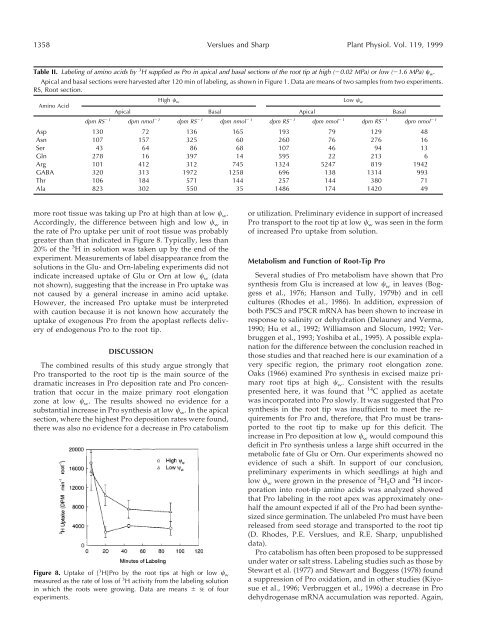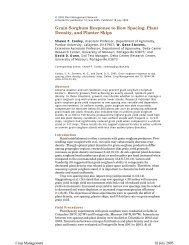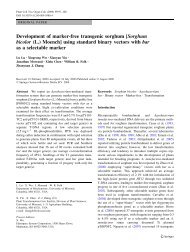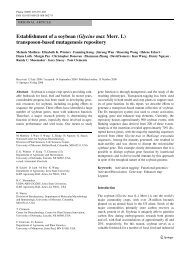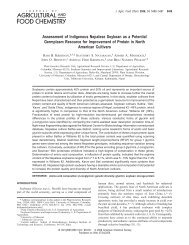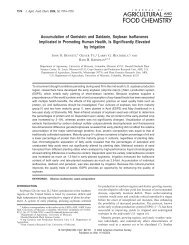Proline Accumulation in Maize (Zea mays L ... - Plant Physiology
Proline Accumulation in Maize (Zea mays L ... - Plant Physiology
Proline Accumulation in Maize (Zea mays L ... - Plant Physiology
Create successful ePaper yourself
Turn your PDF publications into a flip-book with our unique Google optimized e-Paper software.
1358 Verslues and Sharp <strong>Plant</strong> Physiol. Vol. 119, 1999<br />
Table II. Label<strong>in</strong>g of am<strong>in</strong>o acids by 3 H supplied as Pro <strong>in</strong> apical and basal sections of the root tip at high (0.02 MPa) or low (1.6 MPa) w .<br />
Apical and basal sections were harvested after 120 m<strong>in</strong> of label<strong>in</strong>g, as shown <strong>in</strong> Figure 1. Data are means of two samples from two experiments.<br />
RS, Root section.<br />
Am<strong>in</strong>o Acid<br />
High w<br />
Low w<br />
Apical Basal Apical Basal<br />
dpm RS 1 dpm nmol 1 dpm RS 1 dpm nmol 1 dpm RS 1 dpm nmol 1 dpm RS 1 dpm nmol 1<br />
Asp 130 72 136 165 193 79 129 48<br />
Asn 107 157 325 60 260 76 276 16<br />
Ser 43 64 86 68 107 46 94 13<br />
Gln 278 16 397 14 595 22 213 6<br />
Arg 101 412 312 745 1324 5247 819 1942<br />
GABA 320 313 1972 1258 696 138 1314 993<br />
Thr 106 184 571 144 257 144 380 71<br />
Ala 823 302 550 35 1486 174 1420 49<br />
more root tissue was tak<strong>in</strong>g up Pro at high than at low w .<br />
Accord<strong>in</strong>gly, the difference between high and low w <strong>in</strong><br />
the rate of Pro uptake per unit of root tissue was probably<br />
greater than that <strong>in</strong>dicated <strong>in</strong> Figure 8. Typically, less than<br />
20% of the 3 H <strong>in</strong> solution was taken up by the end of the<br />
experiment. Measurements of label disappearance from the<br />
solutions <strong>in</strong> the Glu- and Orn-label<strong>in</strong>g experiments did not<br />
<strong>in</strong>dicate <strong>in</strong>creased uptake of Glu or Orn at low w (data<br />
not shown), suggest<strong>in</strong>g that the <strong>in</strong>crease <strong>in</strong> Pro uptake was<br />
not caused by a general <strong>in</strong>crease <strong>in</strong> am<strong>in</strong>o acid uptake.<br />
However, the <strong>in</strong>creased Pro uptake must be <strong>in</strong>terpreted<br />
with caution because it is not known how accurately the<br />
uptake of exogenous Pro from the apoplast reflects delivery<br />
of endogenous Pro to the root tip.<br />
DISCUSSION<br />
The comb<strong>in</strong>ed results of this study argue strongly that<br />
Pro transported to the root tip is the ma<strong>in</strong> source of the<br />
dramatic <strong>in</strong>creases <strong>in</strong> Pro deposition rate and Pro concentration<br />
that occur <strong>in</strong> the maize primary root elongation<br />
zone at low w . The results showed no evidence for a<br />
substantial <strong>in</strong>crease <strong>in</strong> Pro synthesis at low w . In the apical<br />
section, where the highest Pro deposition rates were found,<br />
there was also no evidence for a decrease <strong>in</strong> Pro catabolism<br />
Figure 8. Uptake of [ 3 H]Pro by the root tips at high or low w<br />
measured as the rate of loss of 3 H activity from the label<strong>in</strong>g solution<br />
<strong>in</strong> which the roots were grow<strong>in</strong>g. Data are means SE of four<br />
experiments.<br />
or utilization. Prelim<strong>in</strong>ary evidence <strong>in</strong> support of <strong>in</strong>creased<br />
Pro transport to the root tip at low w was seen <strong>in</strong> the form<br />
of <strong>in</strong>creased Pro uptake from solution.<br />
Metabolism and Function of Root-Tip Pro<br />
Several studies of Pro metabolism have shown that Pro<br />
synthesis from Glu is <strong>in</strong>creased at low w <strong>in</strong> leaves (Boggess<br />
et al., 1976; Hanson and Tully, 1979b) and <strong>in</strong> cell<br />
cultures (Rhodes et al., 1986). In addition, expression of<br />
both P5CS and P5CR mRNA has been shown to <strong>in</strong>crease <strong>in</strong><br />
response to sal<strong>in</strong>ity or dehydration (Delauney and Verma,<br />
1990; Hu et al., 1992; Williamson and Slocum, 1992; Verbruggen<br />
et al., 1993; Yoshiba et al., 1995). A possible explanation<br />
for the difference between the conclusion reached <strong>in</strong><br />
those studies and that reached here is our exam<strong>in</strong>ation of a<br />
very specific region, the primary root elongation zone.<br />
Oaks (1966) exam<strong>in</strong>ed Pro synthesis <strong>in</strong> excised maize primary<br />
root tips at high w . Consistent with the results<br />
presented here, it was found that 14 C applied as acetate<br />
was <strong>in</strong>corporated <strong>in</strong>to Pro slowly. It was suggested that Pro<br />
synthesis <strong>in</strong> the root tip was <strong>in</strong>sufficient to meet the requirements<br />
for Pro and, therefore, that Pro must be transported<br />
to the root tip to make up for this deficit. The<br />
<strong>in</strong>crease <strong>in</strong> Pro deposition at low w would compound this<br />
deficit <strong>in</strong> Pro synthesis unless a large shift occurred <strong>in</strong> the<br />
metabolic fate of Glu or Orn. Our experiments showed no<br />
evidence of such a shift. In support of our conclusion,<br />
prelim<strong>in</strong>ary experiments <strong>in</strong> which seedl<strong>in</strong>gs at high and<br />
low w were grown <strong>in</strong> the presence of 2 H 2 O and 2 H <strong>in</strong>corporation<br />
<strong>in</strong>to root-tip am<strong>in</strong>o acids was analyzed showed<br />
that Pro label<strong>in</strong>g <strong>in</strong> the root apex was approximately onehalf<br />
the amount expected if all of the Pro had been synthesized<br />
s<strong>in</strong>ce germ<strong>in</strong>ation. The unlabeled Pro must have been<br />
released from seed storage and transported to the root tip<br />
(D. Rhodes, P.E. Verslues, and R.E. Sharp, unpublished<br />
data).<br />
Pro catabolism has often been proposed to be suppressed<br />
under water or salt stress. Label<strong>in</strong>g studies such as those by<br />
Stewart et al. (1977) and Stewart and Boggess (1978) found<br />
a suppression of Pro oxidation, and <strong>in</strong> other studies (Kiyosue<br />
et al., 1996; Verbruggen et al., 1996) a decrease <strong>in</strong> Pro<br />
dehydrogenase mRNA accumulation was reported. Aga<strong>in</strong>,


